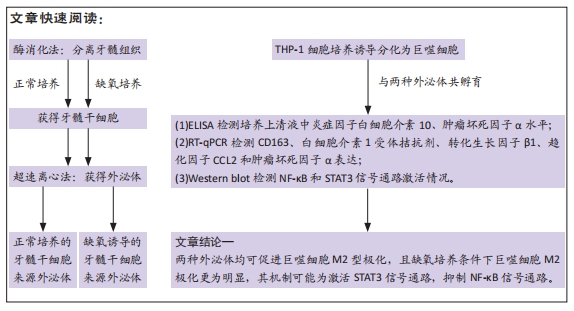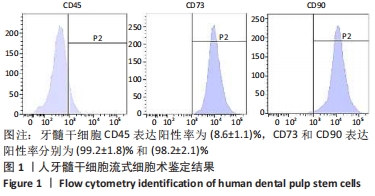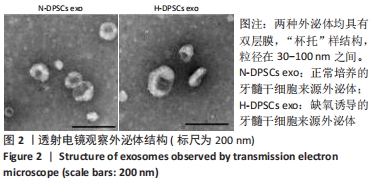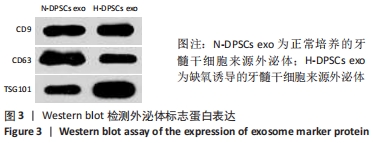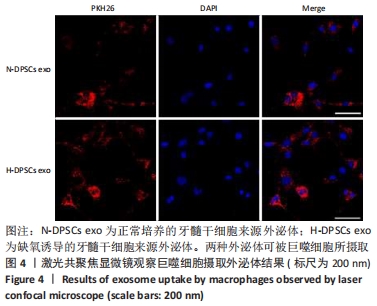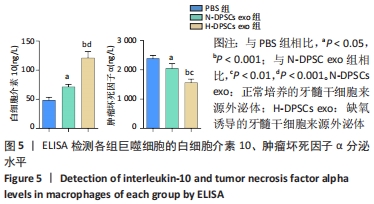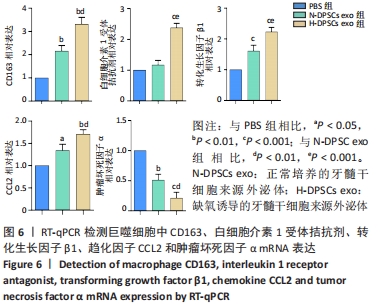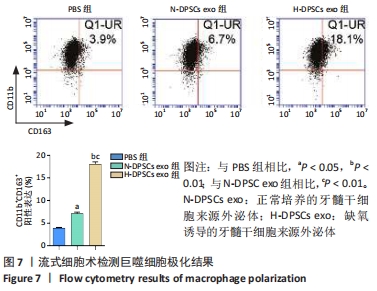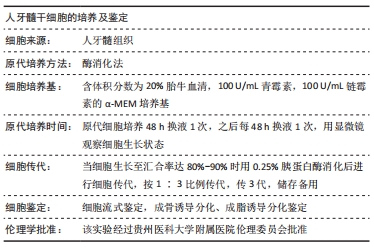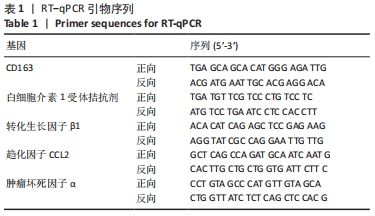[1] MEAD B, LOGAN A, BERRY M, et al. Concise Review: Dental Pulp Stem Cells: A Novel Cell Therapy for Retinal and Central Nervous System Repair. Stem Cells. 2017;35(1):61-67.
[2] JI L, BAO L, GU Z, et al. Comparison of immunomodulatory properties of exosomes derived from bone marrow mesenchymal stem cells and dental pulp stem cells. Immunol Res. 2019;67(4-5):432-442.
[3] 曾宪海,萧苑,邓祖辉,等.人牙髓间充质干细胞外泌体对小鼠树突状细胞成熟和功能的抑制作用[J].中华微生物学和免疫学杂志, 2019,39(7):506-513.
[4] LANCASTER GI, FEBBRAIO MA. Exosome-dependent trafficking of HSP70: a novel secretory pathway for cellular stress proteins. J Biol Chem. 2005;280(24):23349-23355.
[5] LI J, JU Y, LIU S, et al. Exosomes derived from lipopolysaccharide-preconditioned human dental pulp stem cells regulate Schwann cell migration and differentiation. Connect Tissue Res. 2021;62(3):277-286.
[6] PIVORAITĖ U, JARMALAVIČIŪTĖ A, TUNAITIS V, et al. Exosomes from Human Dental Pulp Stem Cells Suppress Carrageenan-Induced Acute Inflammation in Mice. Inflammation. 2015;38(5):1933-1941.
[7] JARMALAVIČIŪTĖ A, TUNAITIS V, PIVORAITĖ U, et al. Exosomes from dental pulp stem cells rescue human dopaminergic neurons from 6-hydroxy-dopamine-induced apoptosis. Cytotherapy. 2015;17(7):932-939.
[8] BONAVENTURA G, INCONTRO S, IEMMOLO R, et al. Dental mesenchymal stem cells and neuro-regeneration: a focus on spinal cord injury. Cell Tissue Res. 2020;379(3):421-428.
[9] MOHAN SP, RAMALINGAM M. Dental Pulp Stem Cells in Neuroregeneration. J Pharm Bioallied Sci. 2020;12(Suppl 1):S60-S66.
[10] ALTANER C, ALTANEROVA V, CIHOVA M, et al. Complete regression of glioblastoma by mesenchymal stem cells mediated prodrug gene therapy simulating clinical therapeutic scenario. Int J Cancer. 2014; 134(6):1458-1465.
[11] 刘佳宁,王鑫雅,孙玥.巨噬细胞极化对炎症性疾病影响的研究进展[J].生物化工,2020,6(1):112-115.
[12] BURAVKOVA LB, ANDREEVA ER, GOGVADZE V, et al. Mesenchymal stem cells and hypoxia: where are we? Mitochondrion. 2014;19 Pt A:105-112.
[13] 赵敏,冯柳祥,陈垚,等.低氧环境下外泌体可作为疾病的标志物[J].中国组织工程研究,2021,25(7):1104-1108.
[14] 黄芳.缺氧预处理牙髓干细胞治疗根尖周炎骨缺损的研究[D].武汉:华中科技大学,2016.
[15] WU Y, HUANG F, ZHOU X, et al. Hypoxic Preconditioning Enhances Dental Pulp Stem Cell Therapy for Infection-Caused Bone Destruction. Tissue Eng Part A. 2016;22(19-20):1191-1203.
[16] TSUTSUI TW. Dental Pulp Stem Cells: Advances to Applications. Stem Cells Cloning. 2020;13:33-42.
[17] SUI B, WU D, XIANG L, et al. Dental Pulp Stem Cells: From Discovery to Clinical Application. J Endod. 2020;46(9S):S46-S55.
[18] CHEN W, ZHUO Y, DUAN D, et al. Effects of Hypoxia on Differentiation of Mesenchymal Stem Cells. Curr Stem Cell Res Ther. 2020;15(4):332-339.
[19] LIU J, HAO H, XIA L, et al. Hypoxia pretreatment of bone marrow mesenchymal stem cells facilitates angiogenesis by improving the function of endothelial cells in diabetic rats with lower ischemia. PLoS One. 2015;10(5):e0126715.
[20] VANACKER J, VISWANATH A, DE BERDT P, et al. Hypoxia modulates the differentiation potential of stem cells of the apical papilla. J Endod. 2014;40(9):1410-1418.
[21] CHUNG IM, RAJAKUMAR G, VENKIDASAMY B, et al. Exosomes: Current use and future applications. Clin Chim Acta. 2020;500:226-232.
[22] CHEN BY, SUNG CW, CHEN C, et al. Advances in exosomes technology. Clin Chim Acta. 2019;493:14-19.
[23] CONSOLE L, SCALISE M, INDIVERI C. Exosomes in inflammation and role as biomarkers. Clin Chim Acta. 2019;488:165-171.
[24] PULLAN JE, CONFELD MI, OSBORN JK, et al. Exosomes as Drug Carriers for Cancer Therapy. Mol Pharm. 2019;16(5):1789-1798.
[25] 何泓志,麻丹丹.牙髓干细胞外泌体的研究进展[J].口腔疾病防治, 2019,27(10):652-657.
[26] HUANG CC, NARAYANAN R, ALAPATI S, et al. Exosomes as biomimetic tools for stem cell differentiation: Applications in dental pulp tissue regeneration. Biomaterials. 2016;111:103-115.
[27] 苏晓磊,张庆林,靳继德,等.牙髓干细胞来源的外泌体对急性肺损伤的作用及机制研究[J].军事医学,2018,42(2):130-137.
[28] ALTANEROVA U, BENEJOVA K, ALTANEROVA V, et al. Dental pulp mesenchymal stem/stromal cells labeled with iron sucrose release exosomes and cells applied intra-nasally migrate to intracerebral glioblastoma. Neoplasma. 2016;63(6):925-933.
[29] ATRI C, GUERFALI FZ, LAOUINI D. Role of Human Macrophage Polarization in Inflammation during Infectious Diseases. Int J Mol Sci. 2018;19(6):1801.
[30] LIU J, CHEN B, BAO J, et al. Macrophage polarization in periodontal ligament stem cells enhanced periodontal regeneration. Stem Cell Res Ther. 2019;10(1):320.
[31] WANG LX, ZHANG SX, WU HJ, et al. M2b macrophage polarization and its roles in diseases. J Leukoc Biol. 2019;106(2):345-358.
[32] PARISI L, GINI E, BACI D, et al. Macrophage Polarization in Chronic Inflammatory Diseases: Killers or Builders? J Immunol Res. 2018; 2018:8917804.
[33] MURRAY PJ. Macrophage Polarization. Annu Rev Physiol. 2017;79:541-566.
[34] DINASARAPU AR, GUPTA S, RAM MAURYA M, et al. A combined omics study on activated macrophages--enhanced role of STATs in apoptosis, immunity and lipid metabolism. Bioinformatics. 2013;29(21):2735-2743.
[35] POLAK KL, CHERNOSKY NM, SMIGIEL JM, et al. Balancing STAT Activity as a Therapeutic Strategy. Cancers (Basel). 2019;11(11):1716.
[36] QUERO L, TIADEN AN, HANSER E, et al. miR-221-3p Drives the Shift of M2-Macrophages to a Pro-Inflammatory Function by Suppressing JAK3/STAT3 Activation. Front Immunol. 2020;10:3087.
[37] HUANG FM, CHANG YC, LEE SS, et al. Expression of pro-inflammatory cytokines and mediators induced by Bisphenol A via ERK-NFκB and JAK1/2-STAT3 pathways in macrophages. Environ Toxicol. 2019;34(4): 486-494.
[38] 柳笑彦,刘力.代谢及炎症反应相关的巨噬细胞极化调控的研究进展[J].转化医学电子杂志,2018,5(10):92-96.
[39] QIN C, FAN WH, LIU Q, et al. Fingolimod Protects Against Ischemic White Matter Damage by Modulating Microglia Toward M2 Polarization via STAT3 Pathway. Stroke. 2017;48(12):3336-3346.
[40] WANG N, GAO J, JIA M, et al. Exendin-4 Induces Bone Marrow Stromal Cells Migration Through Bone Marrow-Derived Macrophages Polarization via PKA-STAT3 Signaling Pathway. Cell Physiol Biochem. 2017;44(5):1696-1714.
[41] YUAN F, FU X, SHI H, et al. Induction of murine macrophage M2 polarization by cigarette smoke extract via the JAK2/STAT3 pathway. PLoS One. 2014;9(9):e107063.
[42] SUI A, CHEN X, DEMETRIADES AM, et al. Inhibiting NF-κB Signaling Activation Reduces Retinal Neovascularization by Promoting a Polarization Shift in Macrophages. Invest Ophthalmol Vis Sci. 2020; 61(6):4.
[43] DORRINGTON MG, FRASER IDC. NF-κB Signaling in Macrophages: Dynamics, Crosstalk, and Signal Integration. Front Immunol. 2019;10: 705.
[44] ZHANG Y, LIU F, YUAN Y, et al. Inflammasome-Derived Exosomes Activate NF-κB Signaling in Macrophages. J Proteome Res. 2017;16(1): 170-178.
|
